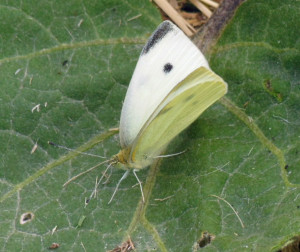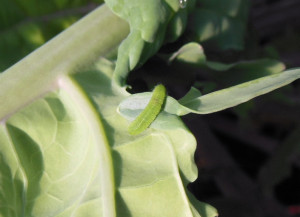Eliminating the Cabbage Worm Naturally
Have you ever wondered why those pretty white butterflies hang around the garden? These are one of the culprits that are doing in your cabbage, broccoli, cauliflower and brussels sprouts. These happy white butterflies (actually Imported Cabbage Worms) are laying eggs on your plants.
There 3 main cabbage worms that will attack your plants are the Imported Cabbage Worm (Pieris rapae), Cabbage Loopers (Trichoplusia ni) and Diamondback Moths (Plutella xylostella). Imported Cabbage Worms are the white butterflies with the black spots (Image 1). Cabbage Loopers are the night flying brown mottled moths. The third cabbage worm that eats your cabbage and other plants is the Diamondback Moths. They are small and brownish with a turned up tail. All three have green larvae that will munch your cabbage, broccoli, cauliflower, lettuce, mustards, Bok Choy and kale.
The moths lay eggs on your plants. These eggs can hatch out in four to eight days, depending on how warm the eggs are. The eggs hatch out into little green worms (Image 2) that reach around an inch long at maturity. The worms will munch on your plants for 7-15 days then they will pupae. After a week or so, depending on the temperatures, the pupae hatches and the adult moth start the cycle all over again. The moths can winter over as pupae in the soil. By rotating your crops to a new spot every year and turning the soil in the fall and early spring to expose the pupae to the cold you can eliminate some of the pupae.

Image 1

Image 2
To eliminate the cabbage worms there are several methods:
- Yellow Jackets will eat the worms. This is nature at her best. I bet you didn’t know that Yellow Jackets were good for anything.
- Bacillus Thuringiensis (BT): This is a bacterial pathogen that is used for biological control over larvae. It is widely used by organic growers. I have used it with great success. It is safe for plants, other beneficial insects, animals and humans. I apply BT once a week starting as soon as I see the white moths flying around the garden. We continue to spray every week until we see no more moths. If you water the plants over head, it will be washed off and will need to be reapplied. We apply in the afternoon on Thursdays. Then on Friday morning we run the sprinklers and most of the BT gets washed off but we do have very good control and do not reapply until the following Thursday. If you are getting a lot of damage then apply twice a week. BT is available at local nurseries; we use a brand named Dipel.
- Repellant drench: In a blender puree spearmint, green onion, garlic, horseradish, hot peppers, peppercorns and water. Add one tablespoon of liquid soap per quart of puree, spray onto plants.
- Flour Powder: Mix 1⁄2 cup of table salt and 1 cup of flour. Sprinkle onto plants while still moist from the morning dew. This mix will bloat and kill the worms.
- Netting: Netting is available for covering the plants in the cabbage family. If you can keep the moths from laying eggs you will get no damaging worms. The plant can grow the entire season under the netting without any loss of crops.
- Diatomaceous earth: Diatomaceous earth is ground up fossilized sea shells. Diatomaceous earth will puncture soft bodied insects and they will dehydrate and die. Local nurseries should carry diatomaceous earth.
- Garlic oil spray: Mince one bulb of garlic and soak in two teaspoons of mineral oil for 24 hours. Next, mix 2 cups of water with one tablespoon liquid soap then add garlic mix to water and soap, mix thoroughly. Strain out garlic and place into a jar for storage, this will be your concentrate. Use one to two tablespoons of garlic oil concentrate to two cups water, then spray plants covering all leaf surfaces. Use for control over aphids, cabbage loopers, earwigs, June bugs, leaf hoppers, squash bugs, and whiteflies.
- Caterpillar deterrent citrus spray: Caterpillars don’t like the taste of citrus; its bitter chemicals run the caterpillars off. To make a citrus spray, grind up the rinds and seeds of any citrus fruit (oranges, lemons, limes or grapefruit). Soak overnight in two cups of water. Strain out the pulp; add two teaspoons liquid soap to mix.
Spray on plants. If you are observant and watch the skies for the moths and then check your plants for the worms, it is easy to see the cycle of the moths taking place. Then you can disrupt the cycle with a spray or manually removing the worms by hand. Observation, identification and a little knowledge will make your organic garden a success. By the way, if you cook your broccoli with the worms on it, they usually float the top of the pot where you can skim them out of the boiling water. I am sure that I have eaten a few without knowing it and I am still alive (more protein for me!)

